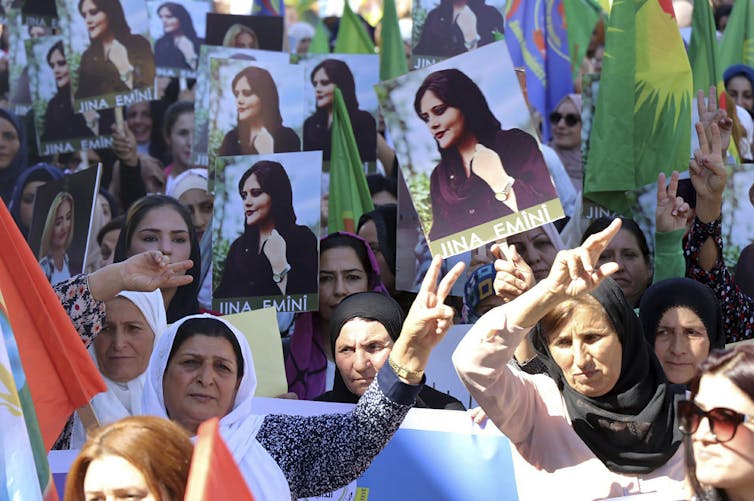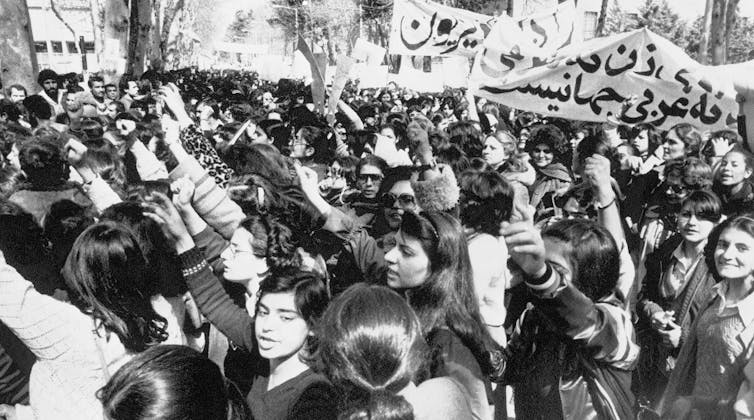
Hawar News Agency via AP via AP
Parichehr Kazemi, University of Oregon
Images of unveiled Iranian women and adolescent girls standing atop police cars or flipping off the ayatollah’s picture have become signature demonstrations of dissent in the past few months of protest in Iran.
In fact, among the Iranian protest photos selected for inclusion in Time magazine’s list of the “Top 100 Photos of 2022” are one of women running from military police brigades and another of an unveiled woman standing on a car with hands raised.
As a scholar studying the use of images in political movements, I find Iranian protest photos powerful and engaging because they play on several elements of defiance. They draw on a longer history of Iranian women taking and sharing photos and videos of actions considered illegal, such as singing and dancing to protest gender oppression.
Pictures in past Iranian movements
Iranian women did not stage mass public demonstrations against restrictions on their freedoms for nearly three decades following the 1979 Islamic Revolution, when protests against compulsory hijab laws were brutally crushed by the Islamic regime.

AP Photo/Richard Tomkins
In the 2009 Iranian Green Movement against election fraud, however, women played a major role. Images of one young female protester, Neda Agha-Soltan, who was fatally shot by security forces during the protest, went viral, catalyzing millions of Iranians to join the protests.
In subsequent protests, visuals have been at the heart of women’s efforts to mobilize against the Islamic Republic. In 2014, women began recording themselves walking, cycling, dancing and singing in public unveiled, under the banner of the “My Stealthy Freedom” movement. Started by Masih Alinejad, an Iranian-born journalist based in New York, the movement protested the forced wearing of the hijab and other restrictive laws by showing women breaking them.
Walking in busy city streets unveiled, riding a bike in parks where such activities are banned for women and joining dance circles in town squares were among the ways in which Iranian women protested oppressive laws and practices.
Four years later, what came to be known as the “Girls of Revolution Street,” protests started with one woman, Vida Movahed, standing atop a utility box on Tehran’s Revolution Street to wave her headscarf on a stick like a flag. Soon, others joined Movahed by repeating her action in other public spaces in Iran.
Images showing dozens of people protesting mandatory veiling in this way were widely shared on social media and later picked up by global news networks, bringing international attention to women’s resistance efforts in Iran.
The use of images by protesters has been a central practice of resistance in other protests around the world as well. During the Arab Spring, a series of protests against the ruling regimes that spread across the Middle East and North Africa in the early 2010s, images played an important role in mobilizing people into joining the movement.
A photo of a woman dragged by government forces in the streets of Egypt with her body exposed persuaded many to protest against what was a clear example of state violence in the Egyptian uprising. These images challenged the regime interpretations of protesters as “troublemakers” and helped bypass the state-controlled news networks to show the world what was happening on the ground.
What such a resistance means
Iranian women have been protesting the Islamic Republic’s sexist policies and showing the world what freedom and gender identity mean to them through their bodily expressions.
Images of women freely riding a bike or sitting with a member of the opposite sex while unveiled are ways of protesting through the everyday acts that women are barred from under the Islamic Republic. Through their widespread participation in these actions, women have shown a solidarity.
As it is difficult for the Islamic Republic to suppress this kind of protest, it often responds by arresting key activists who can be identified and imprisoning them for several years. In 2019, one activist associated with this form of protest, Yasaman Aryani, was sentenced to a 16-year jail term after a video surfaced of her handing out flowers in the Tehran metro unveiled.
Images of Iranian women engaged in defiant acts make their daily oppression visible. Scholar Mona Lilja describes these protests in terms of “resisting bodies” that speak in ways that are not always apparent at the outset of a demonstration or public act of defiance. Emotions, symbolic actions and women’s engagements with the spaces in which they protest combine to form the meaning of resistance we associate with these pictures.
Today’s protest pictures build on past resistance efforts and build on a tradition of resisting the Iranian government.![]()
Parichehr Kazemi, PhD Candidate, University of Oregon
This article is republished from The Conversation under a Creative Commons license. Read the original article.
















